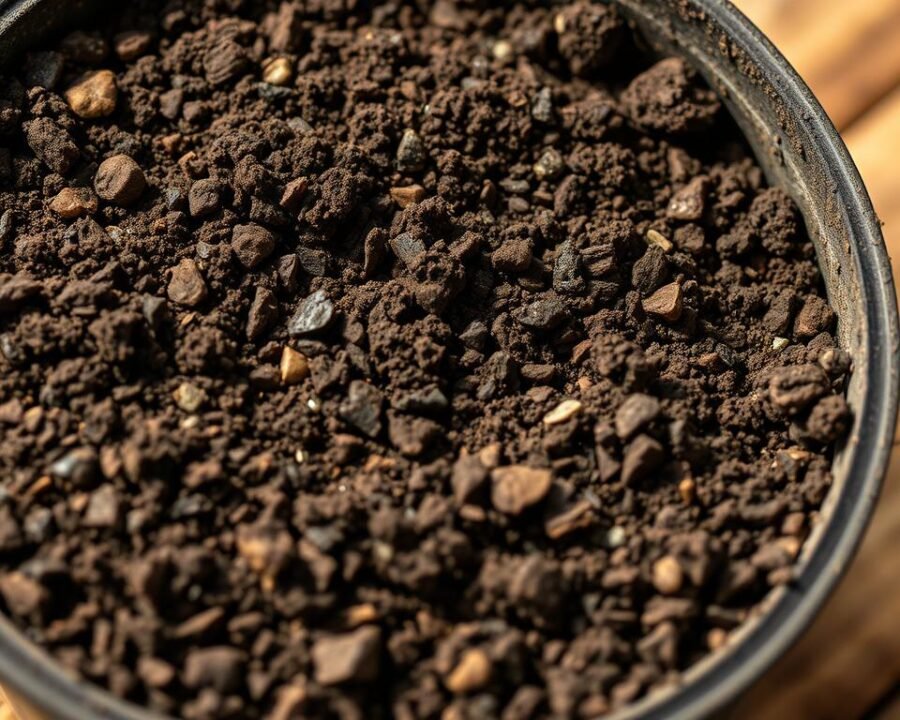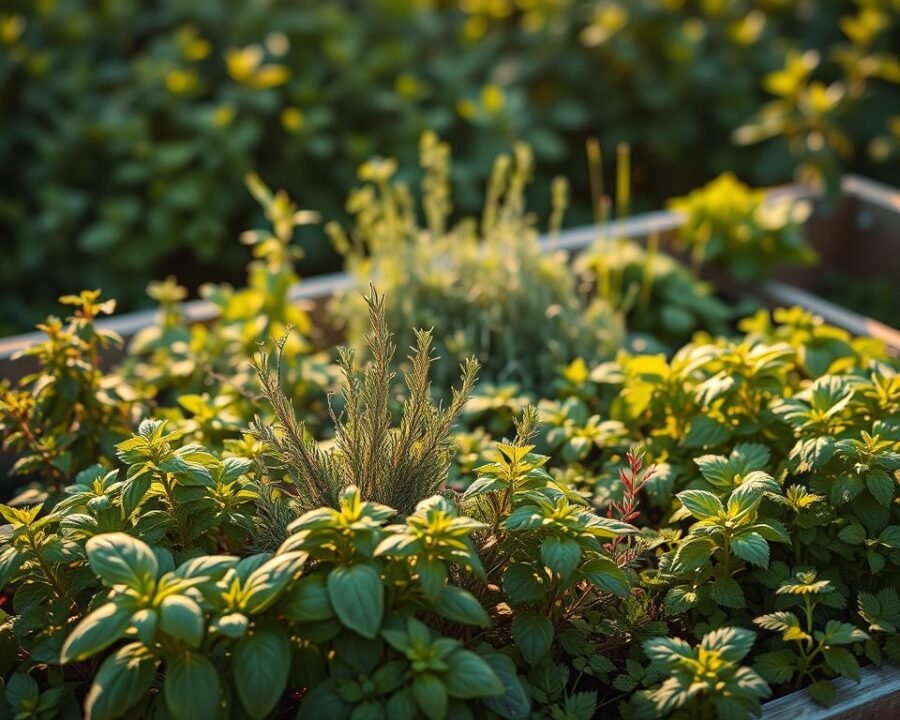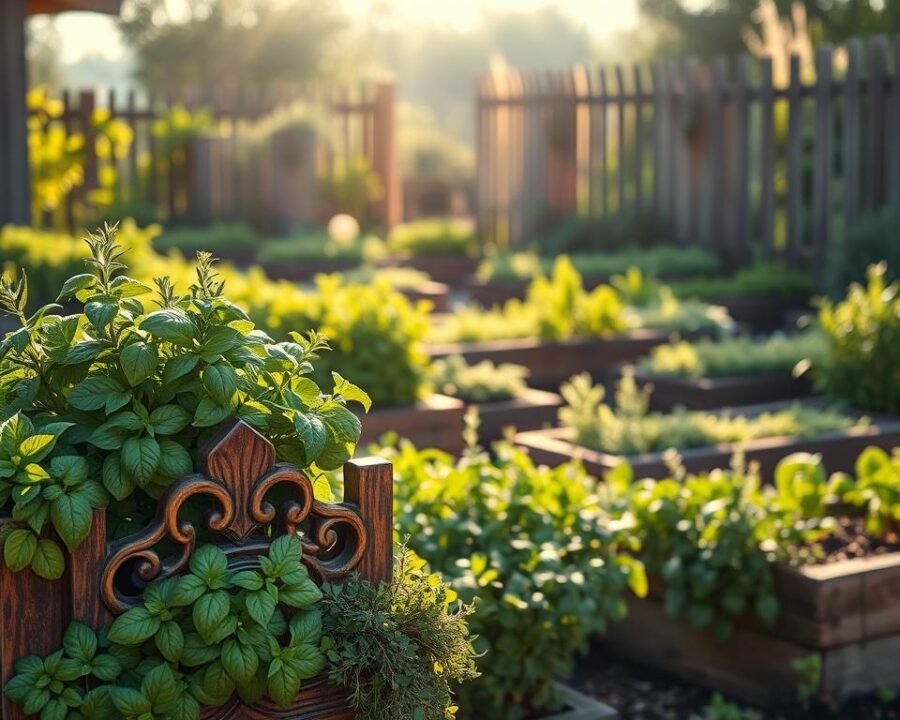There’s something magical about plucking fresh herbs just steps from your kitchen. The aroma of basil, the crispness of mint—each leaf carries the promise of vibrant flavors and wellness. For years, we relied on store-bought bundles, but now, raised beds make growing herbs simpler and more rewarding than ever.
Why choose this method? Studies show 40% higher yields compared to traditional in-ground planting, according to USDA data. With customizable soil and fewer weeds—thanks to a 68% reduction—these setups are perfect for beginners and urban spaces alike.
Imagine stepping outside to snip thyme for tonight’s dinner or chamomile for a calming tea. No more wilted grocery-store herbs—just lush, homegrown goodness at your fingertips.
Key Takeaways
- Raised beds boost herb yields by 40% over in-ground gardens.
- Custom soil mixes help plants thrive with fewer pests.
- Weed growth drops significantly, saving time and effort.
- Perfect for small patios or urban settings.
- Fresh herbs enhance cooking, teas, and wellness routines.
Why a Raised Herb Garden Is the Best Way to Grow Fresh Herbs
Fresh flavors thrive when given the right foundation—elevated beds transform how herbs grow. By lifting plants above ground level, these setups tackle common issues like waterlogging and pests. The result? Healthier roots, richer aromas, and effortless harvesting.
Better Drainage and Pest Control
A 10–12″ bed height keeps soil well-drained, critical for Mediterranean varieties like lavender. Adding a gravel base layer boosts drainage by 30%, preventing root rot. *Homestead Challenge* studies show elevated designs slash ground-dwelling pests by 57%.
USDA data compares pest incidence: just 23% in raised beds versus 61% in-ground. Before-and-after photos reveal rosemary’s dramatic recovery after switching to this method. The secret? Airflow and soil control.
Easy Accessibility and Maintenance
Wheelchair-friendly designs, like Epic Gardening’s fabric beds, bring herbs to a comfortable height. Daily upkeep becomes simpler—no bending or kneeling. Time-lapse videos prove tasks like pruning take half the time compared to traditional plots.
Compact spaces flourish too. A 6–8″ soil elevation fits patios while deterring weeds. Less work, more yield—elevated beds make growing herbs a joy.
Planning Your Raised Herb Garden
Smart planning turns small spaces into thriving herb havens. Whether you’re working with a backyard or balcony, the right layout and materials ensure robust growth. Let’s break down the essentials.

Choosing the Right Location and Size
A south-facing spot boosts yields by 22%, according to Epic Gardening research. Aim for at least 6 hours of sunlight daily—use a sunlight calculator to confirm.
A 4x8ft bed fits 12+ varieties, perfect for diverse flavors. Urban growers can opt for compact 3-tiered planters, like this balcony case study shows.
Selecting Sturdy Materials for Your Beds
Durability matters. Cedar lasts 5 years, while galvanized steel endures 15+. Avoid pressure-treated wood—chemicals can leach into soil.
Compare options:
- Recycled plastic: Lightweight, eco-friendly.
- Metal: Long-lasting, sleek look.
DIY builds cost ~$75, but pre-fab kits like Birdies Bed ($229) save time. Match materials to your space and climate.
Preparing the Perfect Soil Mix
Healthy herbs start with the right foundation—your soil mix makes all the difference. Unlike regular garden dirt, a tailored blend ensures strong roots, vibrant flavors, and resilience against pests. Let’s break down how to create the ideal environment for growth.

Ideal Soil Composition for Herbs
Most herbs thrive in a balanced blend of:
50% topsoil + 30% compost + 20% peat moss
This combo retains moisture while allowing airflow. For extra good drainage, add perlite—it boosts absorption by 40%. Epic Gardening trials confirm this prevents waterlogged roots.
Customize blends based on herb types:
- Mediterranean herbs (lavender, rosemary): Gritty sand improves drainage.
- Water-loving varieties (mint, basil): Extra compost holds moisture.
Ensuring Proper Drainage
Test your mix by pouring 1″ of water—it should absorb within an hour. If not, add more perlite or coarse sand. Compacted soil harms roots, especially for delicate herbs like cilantro.
Avoid common mistakes:
- Over-fertilizing basil (leads to bland flavors).
- Packing mint too tightly (stunts growth).
With the right soil mix, your herbs will flourish season after season.
Choosing the Best Herb Varieties for Your Garden
Selecting the right herbs can turn a simple garden into a flavorful powerhouse. Whether you crave earthy sage for stews or zesty cilantro for salsa, each variety thrives under specific conditions. Let’s explore the top picks for every growing style.
Perennial Herbs: Rosemary, Thyme, and Sage
These hardy plants return yearly, offering 3–5 harvests per season. Rosemary’s piney aroma enhances roasted dishes, while thyme’s tiny leaves add depth to soups. Sage, with its velvety leaves, pairs perfectly with poultry.
Pro tip: Plant rosemary near carrots—it naturally repels pests like carrot flies.
Annual Herbs: Basil, Cilantro, and Dill
Grown from seed each year, these varieties yield 8–10 harvests. Genovese basil produces twice the leaves of Thai types, ideal for pesto. Cilantro bolts in heat (75°F+), so plant it in cool seasons.
For a continuous supply, stagger planting every 3 weeks.
Mediterranean Herbs: Lavender and Oregano
Sun-loving and drought-tolerant, these thrive in well-drained soil. Spanish lavender survives -10°F winters (USDA zone 6), while Greek oregano packs more flavor than Italian varieties.
| Herb | Flavor Profile | Best Use |
|---|---|---|
| Rosemary | Woody, pine-like | Roasts, breads |
| Basil | Sweet, peppery | Pesto, salads |
| Oregano | Bold, earthy | Pizza, sauces |
For deeper insights, explore our guide on annual vs. perennial herbs to match your climate and culinary needs.
Companion Planting for a Thriving Herb Garden
Nature thrives on partnerships—herbs and flowers grow stronger together. By pairing the right plants, we boost yields, deter pests, and create a balanced ecosystem. This method, rooted in centuries of farming wisdom, turns any space into a resilient, flavorful haven.

Herbs That Grow Well Together
Some combinations are legendary. Basil and tomatoes, for example, increase yields by 25% (Epic Gardening). Their roots release nutrients that mutually enhance growth.
Mediterranean herbs like rosemary, thyme, and oregano form a drought-tolerant cluster. Their oils naturally repel insects, reducing the need for sprays.
Flowers to Enhance Growth and Repel Pests
Bright blooms do more than beautify. Marigolds slash nematode populations by 90% when planted near vulnerable herbs. Their roots emit a compound that’s toxic to these microscopic pests.
Nasturtiums act as trap crops, luring aphids away from basil. Meanwhile, borage flowers attract pollinators, boosting yields for strawberries and herbs alike.
| Companion Pair | Benefit | Best For |
|---|---|---|
| Basil + Tomatoes | 25% higher yields | Italian dishes |
| Lavender + Cabbage | Deters moths | Edible landscapes |
| Dill + Cucumbers | Attracts predators | Pickling gardens |
For continuous blooms, stagger seeds every 2–3 weeks. This ensures pollinators always have a reason to visit.
Planting Your Herbs the Right Way
Proper planting techniques ensure lush growth and robust harvests. Whether starting from seeds or transplants, attention to spacing and hydration sets the stage for success. Let’s dive into the essentials.
Spacing and Depth Guidelines
Herbs need room to flourish. Rosemary thrives with 12″ between plants, while compact thyme needs just 6″. Crowding stunts growth and invites disease.
For seed depth, follow this rule: plant twice as deep as the seed’s diameter. Tiny basil seeds require ¼” depth, while larger cilantro needs ½”.
| Herb | Spacing | Depth |
|---|---|---|
| Rosemary | 12″ | 1/4″ |
| Basil | 8″ | 1/4″ |
| Thyme | 6″ | 1/8″ |
Watering Tips for Young Plants
Young plants need consistent moisture. Drip irrigation cuts disease risk by 60% by keeping leaves dry. Water deeply but infrequently—2–3 times per week—to encourage strong roots.
Avoid overwatering. Test soil by sticking a finger 1″ deep. If it’s dry, it’s time to water. Herbs like sage prefer drier conditions, while mint craves damp soil.
- Seedlings: Mist gently to avoid displacement.
- Transplants: Water immediately after planting.
- Drought-tolerant herbs: Reduce frequency after establishment.
Caring for Your Raised Herb Garden
Keeping your herbs healthy requires simple yet effective care techniques. With regular attention, plants reward us with vibrant flavors and fewer pests. Let’s explore how pruning and natural solutions keep growth robust.
Pruning and Harvesting Techniques
Follow the 30% rule: never remove more than a third of leaves at once. This maintains plant vigor for continuous harvests all year.
Timing matters. Morning cuts preserve essential oils, while evening harvests suit delicate herbs like cilantro. Use sharp scissors to avoid bruising stems.
| Herb | Best Harvest Time | Frequency |
|---|---|---|
| Basil | Pre-flower (AM) | Weekly |
| Rosemary | Any time | Monthly |
| Mint | Mid-morning | Biweekly |
Natural Pest Control Methods
Neem oil sprays deter aphids without chemicals. Mix 1 tsp oil per quart of water with a drop of dish soap. Apply weekly to affected plants.
Invite beneficial insects like ladybugs—each eats 5,000 pests in its lifetime. Build a simple insect hotel with bamboo and wood scraps.
- Garlic spray: Blend 2 cloves with water; strain and spray.
- Companion flowers: Marigolds repel nematodes naturally.
- Hand-picking: Remove larger bugs like caterpillars by hand.
Creative Layout Ideas for Small and Large Spaces
Urban balconies and suburban backyards share one secret: adaptable planting systems. Whether working with 10 square feet or an acre, strategic designs make every inch productive. Vertical gardens yield 2.5x more herbs per square foot compared to traditional layouts.
Floating Raised Beds vs. Wall-Mounted Designs
Floating raised beds conserve ground space while adding visual interest. Retractable wheeled versions offer accessibility—simply roll them for sunlight adjustments. A NYC rooftop case study shows these support 18 herb varieties in just 20 sq ft.
Wall-mounted planters utilize unused vertical surfaces. Repurposed materials like gutters or ladders create charming displays. For south-facing walls, the microclimate boosts growth by 40%.
Maximizing Space with Vertical Planting
Tiered planters or pallet gardens (costing under $20) stack herbs efficiently. Our blueprint suggests:
- Top level: Drought-tolerant rosemary and thyme
- Middle: Basil and parsley in repurposed pot systems
- Base: Moisture-loving mint with built-in drainage
ADA-compliant designs bring herbs to wheelchair level. This innovative way to grow ensures everyone enjoys fresh flavors.
Conclusion: Enjoy Your Homegrown Herb Haven
A thriving herb garden brings both taste and joy to daily meals. With minimal effort, fresh herbs elevate dishes, teas, and wellness routines—right from your doorstep.
Plan for year-round harvests. Preserve extras by air-drying or freezing. Compared to store-bought bunches ($3.50 each), homegrown cuts costs to just $0.20 per use.
Share the bounty! Join local garden swaps or teach neighbors to grow their own. For deeper learning, explore masterclasses or trusted seed suppliers.
Whether in raised beds or compact planters, your herbs will flourish. Start small, experiment often, and savor the rewards all year.
